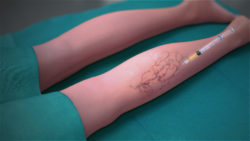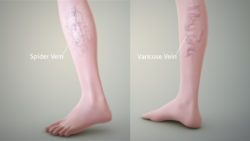Deep vein thrombosis is a condition that occurs when a blood clot develops within a vein that is located deep in the body. Deep Vein Thrombosis (DVT) usually occurs in the veins in the thigh, lower leg, calf or pelvis, but could occur in some other part of the body too.

It is a serious condition and can lead to major health complications. However, it is a condition that is preventable as well as treatable. Sometimes the blood clot breaks free and travels through the bloodstream. This clot can enter the lungs and can block the flow of blood to the lungs and the heart. This condition is called pulmonary embolism (PE) and this is a fatal condition.
Symptoms
In certain cases, there may be no symptoms at all. However, the most common symptoms of Deep Vein Thrombosis are pain, swelling, redness, warmth, cramping and tenderness.
Symptoms of Pulmonary Embolism are coughing up of blood, shortness of breath, chest pain and irregular heartbeat.
Causes
There are a number of factors that increase the chance of developing Deep Vein Thrombosis. DVT can happen at any age, but it is more common in people above 40 years of age. Family history of DVT and Pulmonary Embolism are also a risk factor. Sitting for longer periods, bed rest, pregnancy, obesity, certain medical conditions like cancer, inherited blood disorders, injury to a vein from a fracture or a major surgery, smoking, birth control pills, hormone therapy, are some of the factors that increase the chances of getting DVT.
Treatment
The usual focus of treatment in Deep vein Thrombosis is to
- Stop the clot from getting bigger
- To prevent the blood clot from breaking off and travelling through the bloodstream into the lungs so as to decrease the chances of pulmonary embolism
- Prevent more clots from developing
- Reduce the risk of developing further complications
Thinning the blood with anticoagulants is the first step to treat deep vein thrombosis. Anticoagulants are blood thinners that stop the existing clot from getting bigger and prevent new ones from developing. In some cases anticoagulants cannot be prescribed, then a small cone shaped filter may be inserted into the inferior vena cava, which is the largest vein in the body. The filter is inserted so that it can prevent a clot from entering the lungs.
Certain lifestyle changes such as healthy diet, regular exercise, not smoking, avoiding a sedentary lifestyle and losing excess weight usually help in reducing the risk factor for developing Deep Vein Thrombosis.
Disclaimer: The information in no way constitutes, or should be construed as medical advice. Nor is the above article an endorsement of any research findings discussed in the article an endorsement for any of the source publications.
Sources-
- https://www.webmd.com/dvt/what-is-dvt-and-what-causes-it#2
- https://www.nhs.uk/conditions/deep-vein-thrombosis-dvt/
- https://www.medicalnewstoday.com/articles/153704.php
- https://www.medicinenet.com/deep_vein_thrombosis/article.htm
- https://orthoinfo.aaos.org/en/diseases--conditions/deep-vein-thrombosis
The purpose of treating varicose veins is to fade them. This is done by simply closing them off and redirecting the blood flow through them to other veins. Several types of procedures can do this. Let’s talk about them a little:
Read More..
Varicose and spider veins are the same disease process which differ in severity and size. Spider veins are smaller (1-3 mm) and appear bluish red under the skin, while varicose veins are larger and more dilated veins which typically bulge out above the skin level.
Read More..











